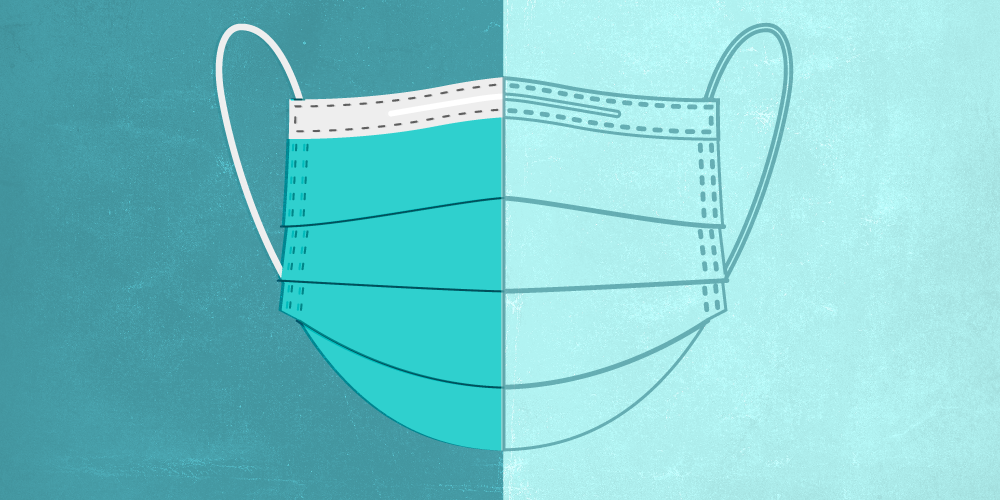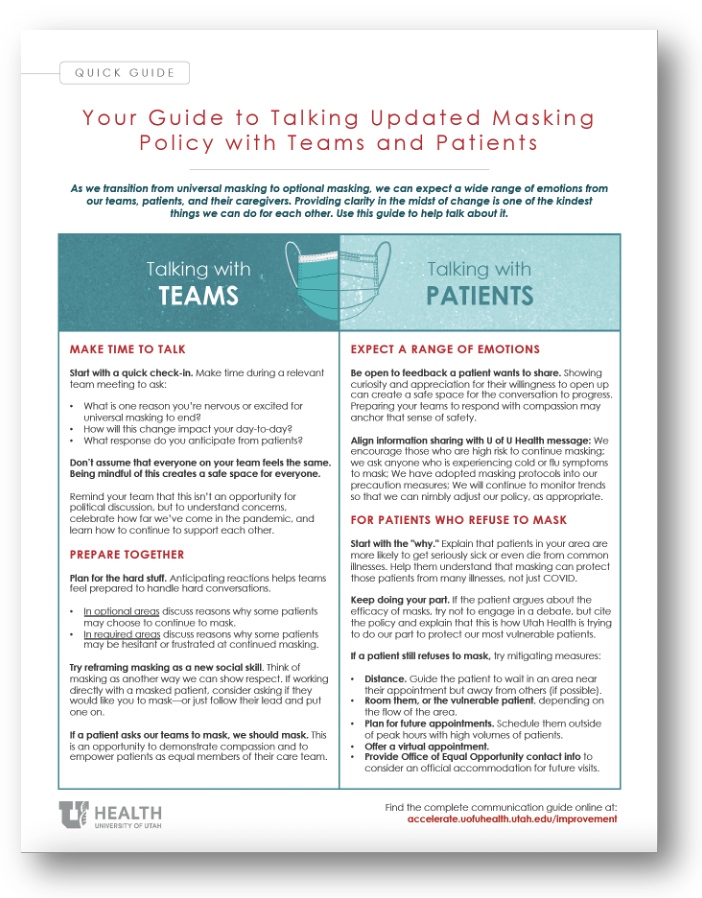t's the time of year we call "respiratory season," when viruses like influenza, RSV, and COVID-19 circulate more widely in the community. While contracting these illnesses may just be an uncomfortable inconvenience for some, they can be very serious illness for others. At University of Utah Health, we are committed to the wellness of our patients and teams.
Wearing a mask is one precaution we can take to limit the spread of respiratory viruses. While universal masking is not expected during this respiratory season, masking may be required in some high-risk clinical locations, or while providing care to immunocompromised patients. Many patients, staff, and providers may independently choose to mask to protect themselves or others close to them.
In our post-COVID environment, wearing a mask may come with a more emotional reaction from patients and teams than in pre-COVID respiratory seasons. It may be a time to exercise trauma-informed leadership. Consider the following as you operationalize the appropriate mask protocols for your area:
Talking to your teams
Make time in a relevant team meeting to talk about plans to approach masking in your area. Be prepared for a range of responses during the conversation and invite appropriate dialogue.
1. Try starting the discussion off with a check-in.
You might ask:
- How will mask protocols impact your day-to-day?
- What response do you anticipate from our patients?
- How can we show compassion to others, regardless of their needs or preferences?
- What was your experience masking during the height of COVID? How is that impacting your feelings about masking today? (if this applies to your team)
You may need to remind your team that this isn’t an opportunity for political discussion, but to understand concerns, take measures to keep our most vulnerable patients safe, and continue learning how to best support each other.
Don’t assume that everyone on your team feels the same way about wearing a mask as you or each other. Being mindful of that can help in creating a safe space for everyone.
2. Prepare together
Plan for the hard stuff. Discuss reasons why some patients may choose to continue to mask. If you are in a required masking area, discuss reasons why some patients may be hesitant or frustrated at continued masking. Anticipating these reasons can help teams tune in to circumstances and mindsets different from their own.
Try reframing masking as a new social skill. In the same way we ask our teams to actively listen to our patients, we can think of masking as a way to show respect. If you’re working directly with a masked patient, consider asking if they would like you to mask—or just follow their lead and wear one for the duration of the interaction.
If a patient asks our teams to mask, we should accommodate that request. This is an opportunity to demonstrate compassion and to empower the patient as an equal member of their care team.
Plan to support your team by adding structural elements, like updated signage, to communicate the need to our patients. Relying on a mix of cues, rather than solely on interpersonal interactions, can reduce the emotional burden for teams. Continue the conversation in staff meetings, check-ins, and other communication venues. This could mean posing questions in your team chat, rounding among your team and patients, or continuing check-ins during huddle. If you notice a team member who seems particularly anxious, talk with them individually.
Talking with and responding to our patients
Just like our teams, our patients may have a range of reactions to increased masking in our facilities. Expect that some patients will feel relieved, and some may feel threatened. Approaching each instance with curiosity, listening, and consistency can help soften tense situations.
1. Be open to actively listen to feedback a patient wants to share.
Showing curiosity and appreciation for their willingness to share can create a safe space for a conversation to progress. Preparing with your teams to respond with compassion may anchor that sense of safety.
2. Align information sharing with U of U Health guidance.
We encourage those who are high risk to continue masking; we ask anyone who is experiencing cold or flu symptoms to mask; we have adopted masking protocols into our precaution measures; and will continue to monitor trends so that we can nimbly adjust our policy, as appropriate.
3. For patients who refuse to mask:
Try partnering with the patient or family. Start with the "why." Explain that patients in your area are more likely to get seriously sick or even die from common infections. If the patient argues about the efficacy of masks, try not to engage in a debate, but cite the policy and explain that this is how U of U Health is trying to do our part to protect our most immunocompromised patients.
If a patient still refuses to mask, try mitigating measures like:
- Distance. Guide the patient to wait in an area near their appointment but away from others, as much as possible.
- Room them, or the immunocompromised patient, depending on the flow of the area.
- Anticipate next time. If possible, schedule their future appointments outside of high-volume times.
- Offer a virtual appointment.
- Offer OEO contact. Provide contact information to the Office of Equal Opportunity to consider an official accommodation for their next appointment.
As a system and a community, we are continuously learning how to approach respiratory season in a post-COVID world. Learning when to mask is a new social skill for us to include in our patient-centered approach.
Some anxiety is expected
In addition to patients experiencing anxiety, some of our team members may be as well.
Talk to your healthcare provider. For staff concerned about their own health and safety, guide them to connect with their healthcare provider to speak about personalized guidance and recommendations.
Personal protective equipment support. Staff who desire additional respiratory PPE are encouraged to talk to their supervisor or manager.
Talk to someone about your concerns. The Resiliency Center is here for individuals who need resources on how to navigate personal apprehension surrounding this change.
Compassion fatigue is real. Staff who are required to mask up more may also experience more feelings of burnout. Increased masking may also remind staff and providers of difficult times treating patients during the height of COVID. We encourage these staff members to work with their department leadership, The Resiliency Center, and/or EAP for support.
With your thoughtful leadership this respiratory season, we can work as effective teams, mitigate emotional harm, and keep our most vulnerable patients healthy.
Kathryn Young
Ember Hunsaker
Mark Shahata
How do I share employee engagement feedback with my team? Chief Wellness Officer Amy Locke, Resiliency Center director Megan Call, Utah Health Academics HR leader Sarah Wilson, and Organizational Development Director Chris Fairbank explain when and how to talk with your team.
COVID-19 has brought a new challenge to the work of continuous learning in health care: how to teach new information when it is constantly changing and emotions run high. As nurse educators for the emergency department, the pulmonary and palliative care unit, and outpatient clinics, Emma Gauci, Paige Wilson, and Sarah Smith have been thrown into an educator’s quandary: how to help staff feel as knowledgeable and supported as possible.
Expert communicators Emily Izzo and Bridgette Maitre share how to ask open-ended questions to encourage conversation and promote meaningful connection.

